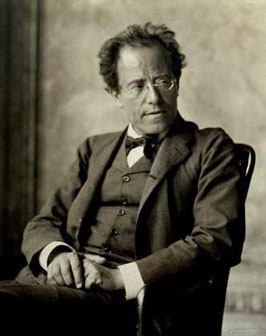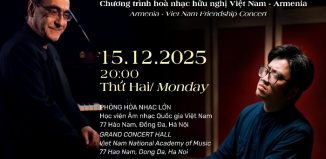KVT – Mahler performance
 |  |
A THOUSAND APPLAUDS
For conductor Ong Honna and chorus master Ong Sutcliffe – and all of the other chorus tutors – not forgetting the concert mistress of the orchestra, a Herculean Heraklean effort has been concluded. For some time now they must have felt as if they too had been sentenced to clean out the ever-fouling Augean stables. But on Saturday night they wiped their brows and Honna gave the first baton beat to start that Herculean piece of musical magnificence, Mahler’s 8th: The Symphony of a Thousand.
The musicians, the singers and the technicians had been rehearsing day and night for a week, and for months before that, to get Mahlerised and must have been on tenterhooks as they took their places and awaited that fateful baton swing.
How did Mahler come out of the wash? More on that later.
There are similarities between the premiere of Mahler’s 8th Symphony in September, 1910 in the Neue Musik-Festhalle in Munich and our performance at The National Convention Center. The vast hall in Munich had a capacity of 3,200…Ours in Hanoi seats 3,800 and both venues had/have acoustic traumas.
Our 2010 performance was scored to fit, as far as possible, the original 1910 score’s intent which had a huge orchestra (including quadruple winds with eight horns, as well as mandolin and harmonium), off-stage brass of four trumpets and three trombones, eight soloists (three soprano, two alto, tenor, baritone, and bass), a double choir, a boys choir and concert organ. We made do with a small organ and baby grand piano. We had a large, well behaved, mixed children’s choir from Hanoi schools while the original had 350 boys from the Munich Zentral-Singschule.
Although Mahler hated the name, the original concert promoter wanted to help ticket sales and so called it ‘the Symphony of a Thousand’ which, today, resonates with Hanoi’s 1000-year birthday.
The Eighth is basically a statement of Mahler’s personal aspirations, a fusion of religion and humanism : a belief in the ability of the inspired spirit to lift mankind to the highest plain of achievement through Love in all its aspects and embodied specifically in “The Eternal Feminine”. This belief can loosely be re-interpreted as an overall theme for Hanoi – the city of Peace in its 1000th year.
For me, the most impressive moment of the whole was the finale of part one, (Come, Creator Spirit) when the hair on the back of my neck stood on end as the trumpets sounded from above and everyone proclaimed optimistically that a new age of enlightenment had dawned.
The second time my hair should have crackled to a rise and I should have spontaneously risen to my feet applauding rapturously should have been at the conclusion to the symphony when the optimism of Goethe’s belief that the soul of man, his feminine aspect, will enable the individual, and mankind, to be redeemed and attain a level of unending greatness, crescendo-ed from a whisper to a triumphant and jubilant, thundering shout.
The climax nearly got me and only failed by a fraction. The second half had sort of waxed and waned in intensity but the soloists managed to maintain a sincerity of depth and the audience was really moved to give a great ovation.
Overall the night was a success. The soloists were fantastic and the orchestra a tightly controlled spring that rarely unraveled except perhaps in the harmonium’s amplification. The choirs were commendable and did all they could, as spread as they were across the vast stage,
to come to grips with Mahler’s intense and difficult vocal score that uses the human voice as essential orchestral instruments.
Was it worth all the effort? Definitely! Yes and yes again! I’m so jealous that I wasn’t able to be one singer in the multitude of voices. I hope that they can all re-group and decide to give us Mahler’s No 2, ‘The Resurrection Symphony’.
Ongs Honna and Sutcliffe deserve great plaudits for their dedication and efforts.
Thanks again and again to all involved.
*Nowadays, in a necessarily feminist Europe, Mahler (or Goethe) wouldn’t get away with their Eternal Feminine philosophizing, but 1910 was in the pre-suffragette era!
![]()
| Not a reviewer, not a critic, “Kiếm Văn Tìm” is an interested, impartial and informed observer and connoisseur of the Hanoi art scene who offers highly opinionated remarks and is part of the long and venerable tradition of anonymous correspondents. Please add your thoughts in the comment field below. |














Dear Sir: Thank you for your fine review of this historic concert. It is a pity that the local English media in Vietnam did not see fit to offer much coverage (e.g., nothing in “Vietnam News” print edition). One correction to your piece: at the first performances in Munich on 12 and 13 Sept. 1910 the children’s choir was a mixed group, the majority of whom were young girls. As you wrote in your piece, they came from the “Städtische Zentral-Singschule” (Municipal Central Singing School).
Sincerely, Michael Bosworth (author of the program notes for the concert, member of Choir II at the performance, and independent researcher on Gustav Mahler’s life and times).
From Henry-Louis de La Grange,
Franco-American Mahler biographer who spent most of his long life, researching, studying, writing on and about Mahler’s life, music, and career,
who visited Hanoi a few years ago, and loved your city,
a message of profound admiration to all those concerned for the Herculian effort which made the impossible possible, the incredible, true!
Henry-Louis de La Grange